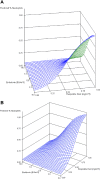An observational study of environmental exposures, airway cytology, and performance in racing thoroughbreds
- PMID: 30222207
- PMCID: PMC6189343
- DOI: 10.1111/jvim.15226
An observational study of environmental exposures, airway cytology, and performance in racing thoroughbreds
Abstract
Background: Mild equine asthma is presumed to arise in response to environmental exposures but the relative impact of differing inflammatory phenotypes upon performance are largely unexplored.
Hypotheses: Airway inflammation negatively affects performance and cytological phenotype varies with environmental exposure.
Animals: Thoroughbred racehorses in active training and racing.
Methods: Thoroughbreds were recruited 24-48 hours before racing. Each horse was eligible for re-enrollment with each race entry. Within one hour of race completion, physical examination, respiratory endoscopy, and BAL were performed. Respirable and inhalable dust, respirable endotoxin, and respirable β-glucan exposures were measured at the breathing zone within one week after racing. Controlling for age, trainer, and pulmonary hemorrhage, the relationship between performance, bronchoalveolar lavage fluid (BALF) cytology, and measures of exposure were modeled.
Results: Performance and BALF data were collected on 64 individual horses from 8 stables for a total of 98 race performances and 79 dust exposure assessments. Evidence of mild equine asthma was found in 80% (78/98) of BALF samples from 52/64 horses. For each percent increase in BALF mast cell and neutrophil proportions, speed figures were reduced by 2.9 (P = .012) and 1.4 (P = .046) points, respectively. Respirable dust concentration was associated with BALF neutrophil proportions (P = .015). Bronchoalveolar lavage fluid mast cell proportions were only associated with respirable β-glucan exposures (P = .030).
Conclusions and clinical importance: Mild equine asthma is common in racing horses and negatively impacts performance. The data support that respirable, rather than inhalable, dust exposure measures are pertinent to equine airway health.
Keywords: beta-glucan; bronchoalveolar lavage; dust; endotoxin; horse; parenchymal disease; pulmonary contusion/hemorrhage; respiratory tract.
© 2018 The Authors. Journal of Veterinary Internal Medicine published by Wiley Periodicals, Inc. on behalf of the American College of Veterinary Internal Medicine.
Figures








References
-
- Holcombe SJ, Robinson NE, Derksen FJ, et al. Effect of tracheal mucus and tracheal cytology on racing performance in Thoroughbred racehorses. Equine Vet J. 2006;38:300–304. - PubMed
-
- Beekman L, Tohver T, Leguillette R. Comparison of cytokine mRNA expression in the bronchoalveolar lavage fluid of horses with inflammatory airway disease and bronchoalveolar lavage mastocytosis or neutrophilia using REST software analysis. JVet Intern Med. 2012;26:153–161. - PubMed
-
- Lavoie JP, Cesarini C, Lavoie‐Lamoureux A, et al. Bronchoalveolar lavage fluid cytology and cytokine messenger ribonucleic Acid expression of racehorses with exercise intolerance and lower airway inflammation. JVet Intern Med. 2011;25:322–329. - PubMed
-
- Bedenice D, Mazan MR, Hoffman AM. Association between cough and cytology of bronchoalveolar lavage fluid and pulmonary function in horses diagnosed with inflammatory airway disease. JVet Intern Med. 2008;22:1022–1028. - PubMed
Publication types
MeSH terms
Grants and funding
LinkOut - more resources
Full Text Sources
Other Literature Sources

